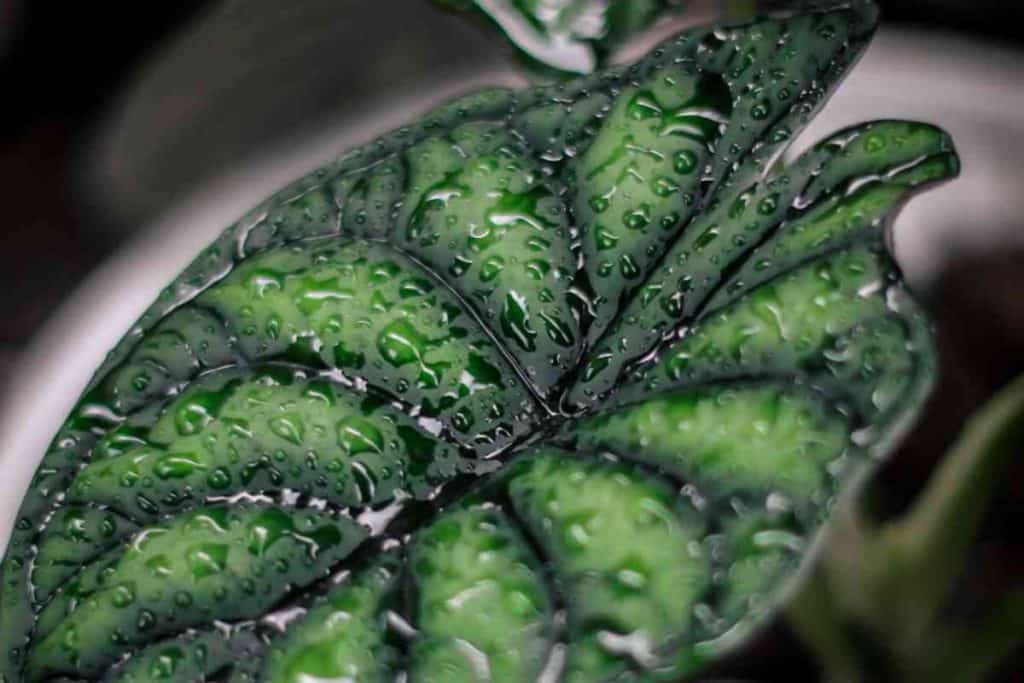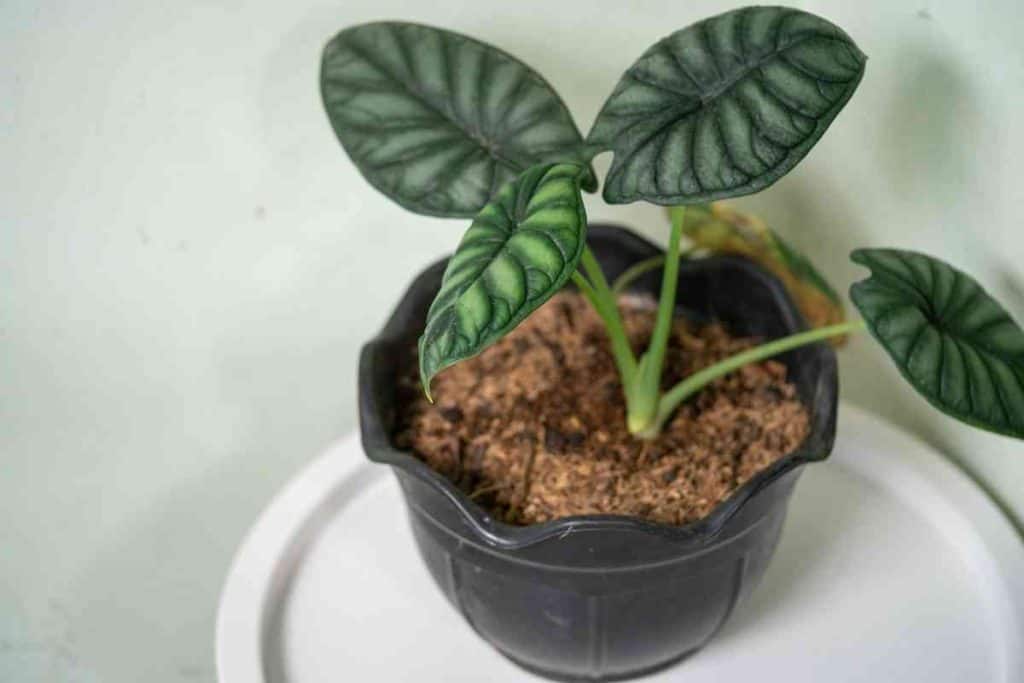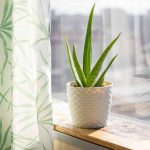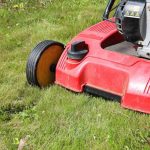We independently research and recommend the best products here. This article contains affiliate links. If you make a purchase after clicking on a link, we may earn a little commission at no extra cost to you.
Alocasia Azlanii is a new and rare species with the most attractive leaves you’ll ever find in any houseplant.
It has a metallic purple color and has a saturated pink hue that stresses the veins, and features an amazing red leaf underneath, thus, making the plant gorgeous on all sides. It will certainly add color and beauty to your home or office.
However, the azlanii requires proper care and maintenance. For instance, it will do well in bright, indirect light and keep it away from heat or cold drafts, as it won’t thrive infrequent temperature changes.
Make sure you water less in winter and feed them moderately. Read on to see the details of the alocasia azlanii care and growing tips.
Table of Contents
Alocasia Azlanii Origin: What is Alocasia Azlanii?
| Common Name | Jewel Alocasia, Red Mambo |
| Botanical Name | Alocasia Azlanii, Novitates Bruneienses |
| Plant Type | Houseplants, Tropical Plants |
| Family | Arum, Araceae |
| Sun Exposure | Bright, Indirect Light |
| Mature Size | Up to 60 cm tall (23.6 inches) |
| Soil Type | Well-draining Soil |
| Leaf Color | Black and Dark Red with White Foliage |
| Native Area | Native to subtropical Asia and Eastern Australia |
| Temperature | Between 65 and 75ºF (18 and 24ºC) |
| Toxicity | Toxic to humans & animals |
| Cool Hardiness | Not cold hardy |
Commonly known as Jewel Alocasia, the alocasia azlanii is a houseplant from the arum family of Araceae that features beautiful deep purple veins on its metallic green leaves.
It is originated from an island in Borneo and can be found in several other habitats like forest clearings and streamsides of Eastern Australia and Sub-tropical Asia.
The azlanii species has only recently been discovered; hence, it is very rare and sought-after because of its amazing features and eye-catching green leaves, which is why it is nicknamed Jewel Alocasia.
Again, as the leaves mature, they begin to look waxy and more beautiful and can grow up to 20cm.
Cultivated around the equator as a foodstuff for 28,000 years, the azlanii is one of 79 alocasia varieties.
Just like other varieties, the azlanii sometimes sheds leave when carried from place to place, but what makes it appealing is that it’s an unyielding plant that will bounce back.
Related Post: How to Grow Turnip Greens in a Container
However, for it to bounce back stronger and better, it will require your help in the form of proper care and attention.
Do not be scared, as the plant is not tricky to care for; hence, you don’t need special experience or skills to harbor the plant. Just follow our basic care guide, and you’re good to go.
Is Alocasia Azlanii Easy To Care For?
Caring for alocasia azlanii is easy. And as we mentioned earlier, caring for the plant is not quite tricky, as you don’t need to be a pro or any special skill to have it around your home.
You only need to know the basic care tips, especially regarding lighting, water, fertilizing and soil requirements, and you’re good to go.
Alocasia Azlanii Care and Growing Tips

Here's everything you need to know about how to grow alocasia azlanii and care for it. This guide will help you to ensure a beautiful and healthy alocasia azlanii plant.
Natural Habitat & Light Requirements
Given that its natural habitat is the Borneo region and other rainforests of Eastern Australia and South-Tropical Asia, where it grows under shades that filters the sun that it gets, the alocasia azlanii will thrive in bright indirect sunlight.
However, it can also tolerate a few hours of the morning sun.
You must also ensure that it stays away from excessive direct sunlight, as it will result in damage to its beautiful leaves.
If you want to bring it out for the early morning sun, you must make sure you’re around to look after it and bring it in when due. You can use artificial spectrum LED during dark times.
Related Post: Alocasia Maharani Care
Watering
Just like several other alocasia varieties, the alocasia azalanii needs water. Watering is one of the trickiest parts of alocasia azlanii care. Yes, they love water, but moderate watering is required instead of overwatering (excessive watering can lead to root rot).
To prevent your plant from experiencing problems, you have to follow the recommended tips by checking the soil at least twice a week to see if the top few inches are dry; and if it is, then it’s time to water.
You make sure that the pot has drainage holes that quickly drain excess water to avoid root rot.
On the other hand, insufficient watering is also disastrous to the azlanii, as it could make the leaves droop and turn to yellow color. Therefore, ensure the water is enough to carry the plant.
Again, reduce watering when you see black or brown spots on the leaves. Meanwhile, the plant needs less water during winter because of dormancy.
Humidity & Temperature
Since the alocasia azlanii is accustomed to growing in a high humidity climate, it will thrive in the humidity of 60% and higher. Keeping the plant at low-humidity levels is disastrous, as it might result in its stunted growth or stress the plant.
Whenever you see brown spots and brown leaf edges, it is often a symptom of low levels of humidity. Therefore, if you suspect a low humidity level in the area, you can increase it with an automatic mister or spray the leaves two-three times with a spray bottle filled with water.
As far as its temperature is concerned, the azlanii thrives in temperatures between 65 to 75ºF (18 to 24ºC). Ensure you do not keep the plant in cold drafts and avoid sudden temperature changes because it will stress it and make it susceptible to diseases and pests.
Soil Requirements
To get the best out of your alocasia azlanii, you must be mindful of the kind of soil you plant it, including soil condition. You must use a soil-less and well-draining alocasia potting mix if you want to enjoy your plant and keep it happy.
Like other alocasias, the azlanii enjoys an airy soil around the roots; therefore, a loose and ideally soil-less mixture will do the trick.
Read Also: Alocasia Sumo Care
Fertilizing Needs
Feeding your plant replenishes the essential nutrients that are depleted in the soil. In other words, since alocasia azlanii is a heavy feeder, you must ensure you feed it at least once a month during the spring and summer when the plant needs more nutrients.
When using fertilizer, make sure you do not overfeed, just like some inexperienced gardeners do. Over-fertilizing will not make the plant grow bigger and healthier but will only cause the plant to burn.
We recommended ½ of diluted balanced fertilizer to guarantee that the fertilizer won’t burn your plant.
Planting (Potting & Repotting)
As long as the planting of alocasia azlanii is concerned, it would be best if you made sure the pot you’re using features a good drainage hole through which excess water drains quickly.
Repot it every two years to encourage new growth. During repotting, please change it to another pot that is slightly bigger than the previous.
How to Prune Alocasia Azlanii
Like several other house plants, the alocasia azlanii requires pruning. To ensure the plant stays attractive and looking at its best, you will have to prune the large leaves of its elephant ear, especially when the occasional cold snap hits its elephant ear.
You can use sharp, clean and sterilized scissors or pruning shears for pruning.
Alocasia Azlanii Propagation

Every houseplant and alocasia variety can be propagated, and the azlanii is not exempted. You can propagate the alocasia azlanii using three methods, namely, division, offsets and seeds methods.
If you want to get the best out of your plant, then you must propagate it in the growing season, in spring and summer, as that is when the roots will sprout quickly.
Propagation by Division Method
The division method is the easiest and most successful method of propagating the alocasia azlanii. Below are the steps required;
- The first thing is to take the plant out of its pot and remove the soil around the roots carefully
- Then, split the rhizome using a sharp knife. Be sure that there are plenty of roots on both parts
- Next, use a well-draining soil mix and plant the divided plant in a pot with drainage holes
Propagation by Offsets Method
To propagate the alocasia azlanii by offsets method, the following steps are required;
- Cut the roots linked to the parent plant with clean pruning shears or sharp knives
- Pull the young plant out of the mother plant carefully – and repot the tiny plant into a smaller container
Note: Do not chop out the offsets once they begin to shoot out. Remove the offsets from the mother plant when they get to a height of 7.5 cm. If the baby is bigger, then propagating the Alocasia azlanii will be a lot successful.
Propagation by Seeds Method
Propagation of the alocasia azlanii using the seeds method requires the following steps;
- Soak the seeds in distilled water overnight – and sow it in a well-draining potting soil. The best time to carry out this process is in the fall season
- Plant the seeds 1 cm deep in the soil. Lightly water the seeds and cover the containers using a plastic bag, this will help to maintain a steady, high humidity level
- Keep the container in bright indirect sunlight, making sure that the soil is kept moist all the time
- Place a heat mat under the containers in order to keep the seedlings warm. The success rate of germination increases when the temperature is warm
- Once the seedlings gets to a height of 5 cm, transplant them carefully into larger pots without injuring the roots
Alocasia Azlanii Varieties
There are precisely over 97 species of Alocasia plants. However, we have decided to briefly highlight the most notable ones, similar to azlanii and widely seen as alocasia azlanii varieties.
They include:
Related Post: Anthurium Vittarifolium Care
Alocasia Amazonica
The alocasia amazonica is a hybrid that is between alocasia longiloba and alocasia sanderiana. It is an exciting prospect, especially for beginners, as it is an easy-maintenance plant and one of the most renowned and non-native houseplants.
Alocasia Zebrina
The alocasia zebrina varieties have foliage that is shield or arrow-shaped. However, it doesn’t have white veins. It features stilt-like stalks with zebra print stylized in black and yellow color.
Alocasia Melo
Also known as Alocasia Rugosa, the alocasia Melo variety has wide, thick green leaves with a hostile texture and obvious deep veins in-between. Generally, the plant is stunted and thrives in small containers or pots.
Frequently Asked Questions
Why Do the Leaves of My Alocasia Azlanii Turn Yellow?
Whenever you notice that your Alocasia azlanii is turning yellow leaves, it shows that the soil has been excessively wet or very dry. Yellowing of leaves can be prevented by watering the plant when the top 2 inches of the soil are dry. Or using a moisture probe, water if you notice the probe shows between 2 and 3.
Why Do The Leaves of My Alocasia Azlanii Turn Brown?
Like other alocasia varieties, whenever the alocasia azlanii leaves turn brown, the obvious explanation is that the plant is experiencing low humidity. It could also be that the potting soil is arid.
Even though some alocasias survive lower humidity levels, their growth will be stunted, as they surely grow best under higher humidity levels (60% and above). You can increase the plant’s humidity level using a mister or occasionally spraying the leaves with water at least twice a week.
Why Is My Alocasia Azlanii Drooping?
The best explanation for the drooping leaves of your alocasia azlanii is if you under-water the plant. In other words, if it lacks water for an extended period, the water balance within the plant can get thrown off, thereby causing the cells inside the stem to lose their strength, and afterwards, start drooping.
Note: Drooping of plant refers to a situation whereby the plant gradually becomes limp or bend, which spell good for any plant. The drooping problem can be prevented by watering the plant regularly but moderately. Make sure you water when the top 2 inches of the soil are dry.
Why Is My Alocasia Azlanii Shedding Leaves?
It is quite simple. It could be that you’re overwatering or underwatering it. To ensure it doesn’t shed leaves, you have to maintain a tight watering schedule and moderate the watering level.
Is the Alocasia Azlanii Toxic?
The alocasia azlanii is toxic to cats, dogs and even humans because every part of the plant has calcium oxalate crystals content. Therefore, when it comes into contact with the mouth, it causes it to irritate. And if consumed, it can be disastrous to the esophagus. Therefore, you must keep it beyond the reach of cats, dogs and kids.
Is the Alocasia Azlanii Rare?
Not only is the alocasia azlanii the rarest, but it is also one of the most beautiful of all the alocasia varieties and an exciting prospect for any home or office.
Read Also: How To Grow Plants In Plastic Bottles




